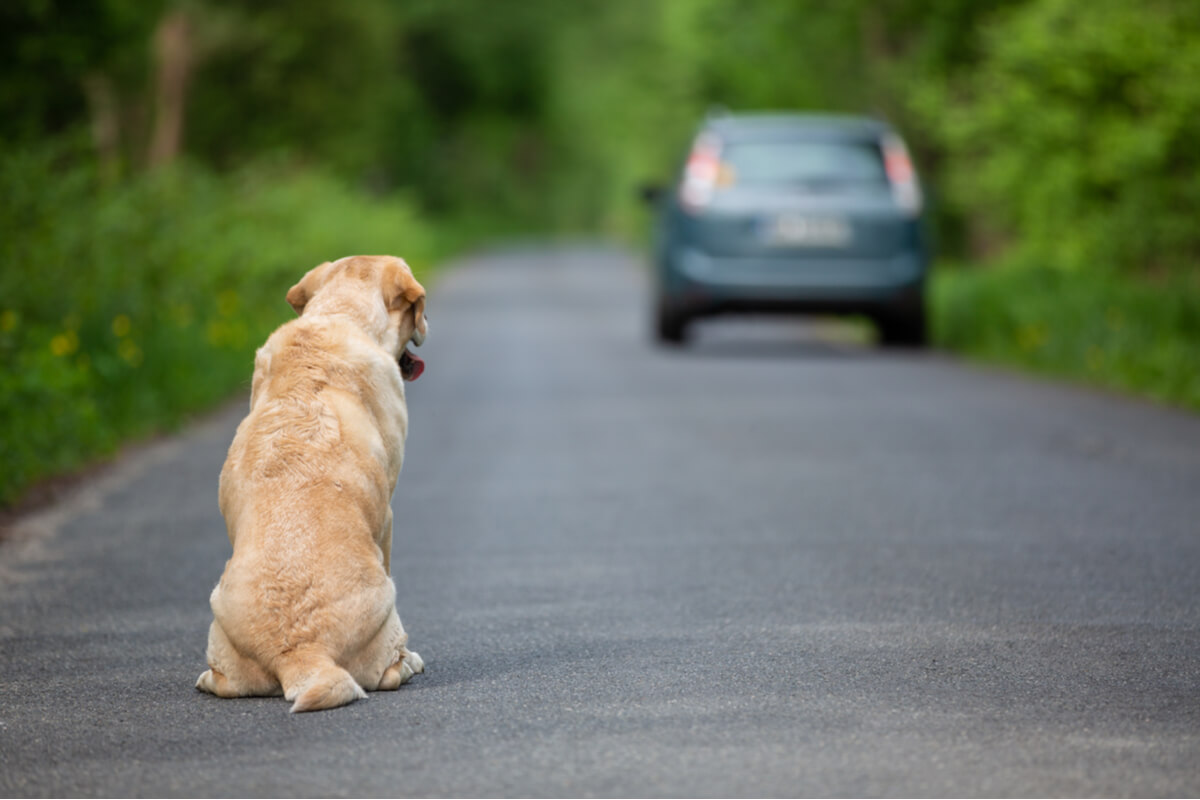10 Ways to Help an Abandoned Dog


Reviewed and approved by the biologist Samuel Sanchez
Many animals are victims of abuse and neglect. Even though you’ll never be able to adopt them all, you can find a way to change their life. Improving their health and housing conditions, playing games, sharing things with them, and helping them find a home are great ways to help an abandoned dog.
Therefore, if you find a homeless animal or if you simply want to help all the abandoned dogs that you come across in your life, here are 10 ways to do it. Keep reading!
1. Help an abandoned dog: take it to the vet
An animal that lives on the street is exposed to diseases, infections, and bacteria all the time. Therefore, if you decide to help an abandoned dog, the first thing you should do for its well-being, yours, and for the good of any other animals that live with you is to take it to the vet.
The important thing is to guarantee their safety and health. At the vet’s they’ll give the dog a check-up, and will evaluate the need to vaccinate and deworm it. Tell the vet how and where you found it, and ask questions about its weight, size, approximate age, and any illnesses it may have.

2. If you don’t have money, you surely have creativity
If you see an abandoned dog and your main reason for doing nothing is that you don’t have enough money to help then, then it’s time to get creative! According to World Animal Protection, there are many ways to get resources:
- You can have a raffle
- Call your family to contribute
- Make a group of godparents
- Look for the free services for animals that your city offers
- Ask among your contacts for a veterinary friend who is willing to donate their time and knowledge
3. Give them a home
It is likely – very likely – that most shelters and NGOs in your city are full and don’t have any space to take the abandoned dog in. However, you never lose anything by asking! However, keep in mind that there’s a big possibility that the home that should house the dog while it finds a definitive family is yours!
The best thing about this is that no one will take care of them as well as you. If you live with more people who may not agree to the dog staying there, then try talking and explaining that it will only be temporary.
If you are able to share your home with the dog, then approach it carefully and let it get used to you so you can take it home without forcing it. Offer it food and put your hand out for him to smell you. Be careful with the reactions you may have and with the vehicles around you. Also, try to use a collar, muzzle, or blanket to wrap it and carry it safely.
4. Give them food and other care
A small area is enough for the dog to shelter from the cold and heat. Make them a makeshift bed with a sheet or blanket and give them food, preferably from a tin. If you can’t afford to buy special dog food, then you can temporarily combine homemade foods like cooked rice, chicken, potatoes, and legumes. Of course, don’t use salt or oil when cooking it.
5. Another way to help an abandoned dog: neutering
Regardless of whether they stay in your house as a foster home or just “passing by”, it’s a great help to castrate the animal. Providing them with a home solves one part of the problem, but surgical sterilization will prevent many others. This prevents disease from spreading and prevents bringing more homeless animals into the world.
So, if you decide to keep the dog with you, make sure they’re sterilized and commit to being their caretaker throughout their life. Bringing animals into the world without a plan for them is an irresponsible act.
6. Lost or abandoned dog?
There’s always the possibility that the dog you’re helping has not been abandoned, but is lost. This is likely if the animal is trained, well-fed, and has a collar. However, regardless of the state it’s in, you can ask close neighbors, businesses, put up street signs, or post on social media.
7. Dog for adoption
Another possibility is that you become so fond of the dog that the person who ultimately wants to adopt them is you! If this isn’t the case for you, and you want to continue helping them to find a home, then you can do it in several ways:
- Ask for help from shelters, organizations, foundations, and all the places that can help you spread the word about adoption.
- Use your social networks. They’re the most efficient forms of communication for these cases.
- Take the dog to an adoption fair.
In all situations it’s important that you tell people how you found the animal, provide details of its personality, its size, its approximate age, and show several photos. It’s also essential that the dog is vaccinated, neutered, and dewormed.
A golden rule in these cases is not to give the dog to the first person who appears, because you must be careful and get to know the person who will give it its new home. An animal is a responsibility for 10 to 20 years and everyone who accepts this commitment must know what this implies.
If the animal ends up in a home where it’s mistreated and poorly fed, what use will all your efforts have been? You can fill out a form where you ask several questions and analyze if you’re willing to give the dog to those people.
Ask if they have other animals, what happened to the ones they had, and what would happen if they could no longer have the animal. Also collect their personal data and ask the future guardians to sign a document of responsibility.
8. Use social networks and the power of the internet
If you’re generally concerned about the situation of abandoned animals, then get involved. Spread information about responsible care, about the importance of sterilizing, vaccinating, and treating all animals with love. By educating you’ll get to the root of the problem. You can also organize educational talks via live videos or at a local vet.
Share profiles of animals for adoption posted by local shelters, and if you know someone who wants a pet, you can encourage them to adopt homeless animals. It’s never too late to give a dog a new home.
9. Make donations to local shelters to help abandoned dogs
Every donation counts when it comes to helping abandoned dogs. If you can support households, animal shelters, or rescue groups with money, do so. In case your budget doesn’t allow it, take a look around your house, and before throwing blankets or towels away ask an animal shelter if they’re interested.
Shelters use blankets and towels in kennels and enclosures to provide more comfortable places for animals to sleep and rest, states Pet Safe. Additionally, your local sanctuary may also receive donations of food, toys, and other pet supplies.
10. Volunteer your services
In addition to donating money and supplies, you can also donate your time and talents. Everything you know and love to do will undoubtedly serve to support many homeless animals. Simply having an extra pair of hands to clean enclosures, fill food bowls, give fresh water, walk, and socialize with animals can make a difference in any shelter.
If your schedule doesn’t allow you to work and help the abandoned shelter dogs, you can do it from home. Many foundations have more animals than space and rely on volunteers to raise them until they find a forever family.
By providing a foster home, you help adoptive animals adjust to the daily routines of a household and get along with other animals, children, and people of all ages.

As you can see, if you want to help an abandoned dog, there are plenty of options. There’s always a way to give affection to that animal that touched your heart while you were walking down the street.
All cited sources were thoroughly reviewed by our team to ensure their quality, reliability, currency, and validity. The bibliography of this article was considered reliable and of academic or scientific accuracy.
Hackett, S. (s. f.). 10 Ways to Help Homeless Pets | PetSafe®. Pet Safe. Recuperado 2 de agosto de 2021, de https://www.petsafe.net/learn/10-ways-to-help-homeless-pets
World Animal Protection. (2020, 10 agosto). 10 pasos para ayudar a un perro o gato abandonado. https://www.worldanimalprotection.cr/noticias/10-pasos-para-ayudar-un-perro-o-gato-en-la-calle
This text is provided for informational purposes only and does not replace consultation with a professional. If in doubt, consult your specialist.